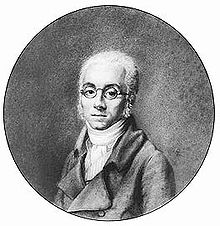Nicolas-Antoine Taunay
| Nicolas-Antoine Taunay | |
|---|---|

Self-portrait (crayon on paper)
|
|
| Born |
10 February 1755 Paris, France |
| Died | 20 March 1830 (aged 75) Paris, France |
| Nationality | French |
| Occupation | Painter |
Nicolas-Antoine Taunay (10 February 1755 – 20 March 1830) was a French painter known best for his landscapes with scenes from ancient and modern history, mythology, and religion.
Nicolas Antoine Taunay was born in Paris, France, in 1755. His father was an enamel painter.
Taunay entered the École des Beaux-Arts in Paris at the age of fifteen and became a pupil of Nicolas-Bernard Lepicié (1735–1784). He later studied in the studios of Nicolas-Guy Brenet (1728–1792) and Francesco Giuseppe Casanova (c. 1732–1803). He specialized in painting landscapes. Taunay first exhibited his work at the Jeunesse and Salon de la Correspondance. In 1784 he was admitted as an assistant at the Royal Academy of Painting and Sculpture. He was now able to exhibit at official shows. Taunay obtained a three-year scholarship to study at the French Academy in Rome in the Palazzo Mancini. While in Italy he met the artist Jacques-Louis David (1748–1825).
After returning to France in 1787 Taunay exhibited in the Paris Salon. He married Josephine Rondel (1768–1844) soon after his return. They had six children, one of them being the also painter Félix Taunay, the father of French-Brazilian author Alfredo d'Escragnolle Taunay. He lived with his family in Montmorency, Val-d'Oise, during the Reign of Terror (1793–1794). He returned to Paris in 1796 and joined the newly formed Institut de France. In 1805 he painted scenes of Napoleon's campaigns in Germany. In 1806 he started contributing work to the Manufacture de Sévres. The Empress Josephine commissioned many paintings of battle scenes from him.
...
Wikipedia
